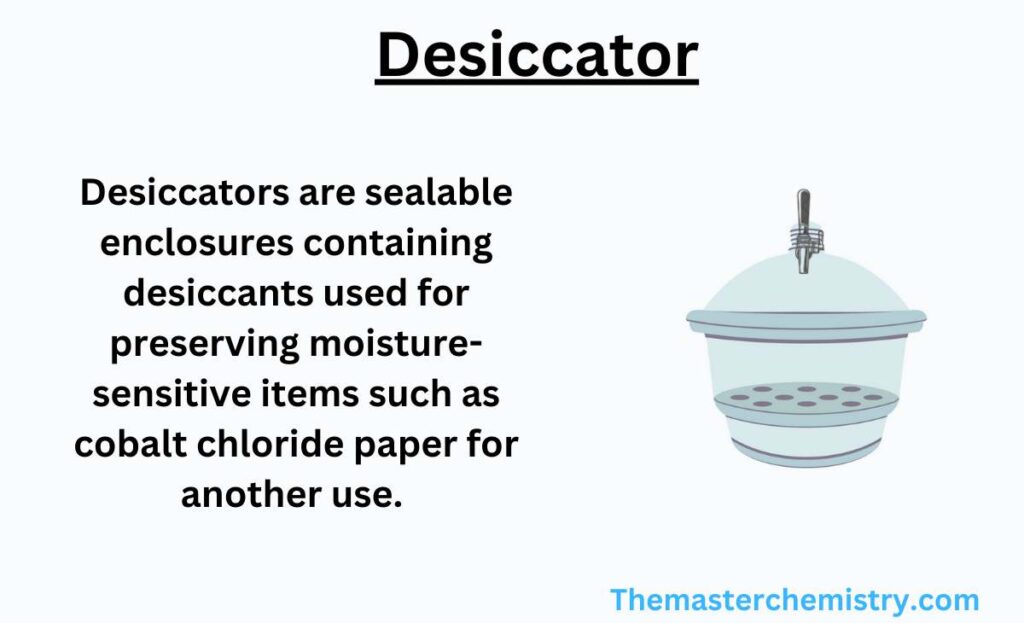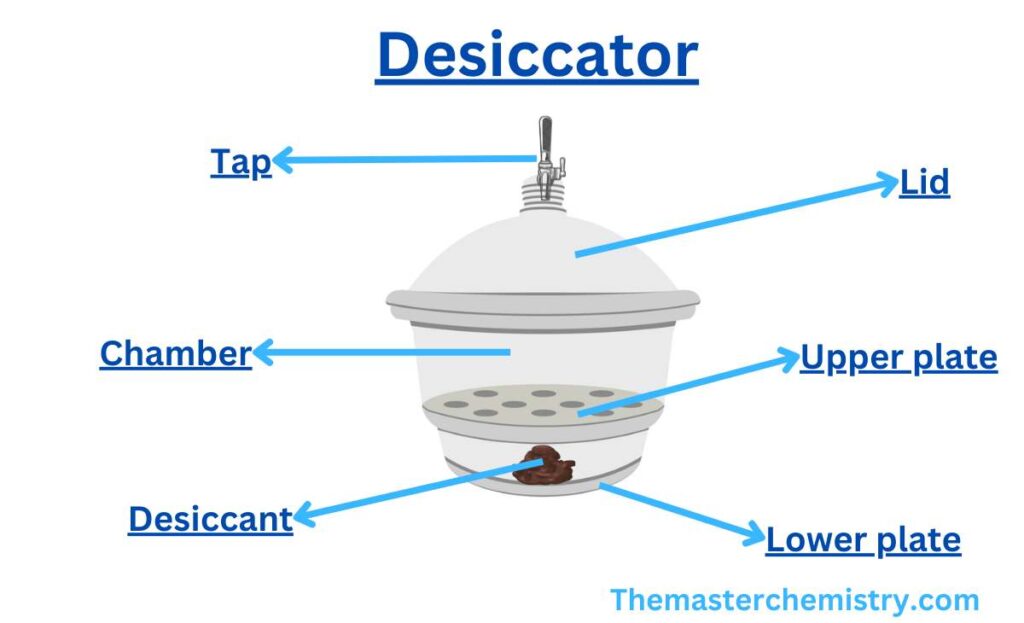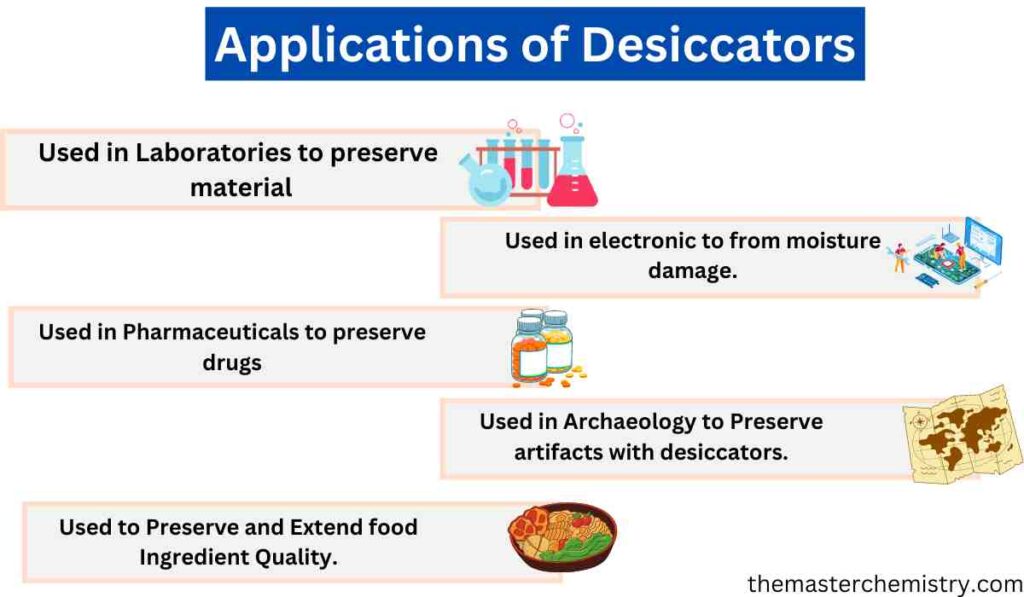What is Desiccator?
Table of Contents
Desiccators are essential tools in laboratories and scientific settings where the preservation of dryness is crucial. These sealed containers create a low-humidity environment, protecting sensitive samples from moisture and humidity.
In this article, we will explore the working principle, components, types, applications, and benefits of desiccators.

I. Understanding Desiccators
A desiccator is a specialized container designed to maintain a low-humidity environment. It prevents the absorption of moisture by utilizing desiccants, such as silica gel or activated charcoal, which absorb and trap water vapor.
II. Working Principle of Desiccators
Desiccators operate based on the principle of moisture removal through desiccants. The process involves the following steps:
1. Desiccant Placement
A desiccant, typically in the form of silica gel or activated charcoal, is placed at the bottom of the desiccator. The desiccant acts as a moisture-absorbing material.
2. Sealing
The desiccator is tightly sealed using a lid or stopper. This creates an airtight chamber, preventing the entry of moisture from the surrounding environment.
3. Moisture Absorption
As the desiccant inside the desiccator absorbs moisture, the relative humidity inside the chamber decreases. This creates a low-humidity environment, protecting the samples or materials placed inside.
4. Moisture Indicator
Some desiccators include a moisture indicator, such as color-changing silica gel, which visually indicates the humidity level inside the desiccator. The color changes based on the moisture absorption, providing a quick visual assessment.
III. Components of a Desiccator
Desiccators consist of several key components:

1. Desiccant
The desiccant is the moisture-absorbing material placed at the bottom of the desiccator. Silica gel and activated charcoal are commonly used desiccants due to their high absorption capacity.
2. Chamber
The chamber of the desiccator is a rigid container that houses the samples or materials to be protected. It is typically made of glass or clear plastic, allowing visual inspection without compromising the seal.
3. Lid or Stopper
The lid or stopper of the desiccator creates an airtight seal when placed on top of the chamber. It ensures that moisture cannot enter or escape the desiccator, maintaining the low-humidity environment.
4. Moisture Indicator
Some desiccators feature a moisture indicator to monitor the humidity level inside the chamber. This indicator helps users assess the effectiveness of the desiccant and determine if it needs replacement.
5. Shelves or Trays
Desiccators may include shelves or trays to organize and separate the samples or materials placed inside. These components allow for better organization and utilization of space within the desiccator.
IV. Types of Desiccators
Desiccators come in different types to cater to specific needs:
1. Vacuum Desiccators
Vacuum desiccators use a vacuum pump to create a low-pressure environment inside the chamber, enhancing the moisture removal process. These desiccators are effective for sensitive samples that require a higher level of dryness.
2. Non-Vacuum Desiccators
Non-vacuum desiccators rely on the desiccant alone for moisture absorption. They are suitable for general-purpose applications and offer a cost-effective solution for moisture protection.
3. Desiccator Cabinets
Desiccator cabinets are larger, freestanding units that contain multiple chambers for storing samples or materials. They provide a controlled and organized environment for various applications.
V. Applications of Desiccators
Desiccators have numerous applications across various fields:

1. Laboratories
Desiccators are commonly used in laboratories to store moisture-sensitive reagents, chemicals, and samples. They ensure the stability and integrity of these materials, preventing degradation.
2. Electronics
In the electronics industry, desiccators protect sensitive electronic components, circuit boards, and devices from moisture-related damage during storage or manufacturing processes.
3. Pharmaceuticals
Desiccators are utilized in the pharmaceutical industry to store moisture-sensitive drugs, preventing moisture absorption and maintaining their efficacy and stability.
4. Archaeology and Museums
Archaeological artifacts and delicate museum specimens often require desiccators to preserve their condition by minimizing moisture-related degradation.
5. Food and Beverage Industry
Desiccators find applications in the food and beverage industry for storing moisture-sensitive ingredients, such as spices, powders, and dried fruits, ensuring their quality and extending shelf life.
Benefits of Desiccators
The benefits of using desiccators include:
1. Moisture protection
Desiccators create a low-humidity environment, safeguarding samples and materials from moisture and humidity-related damage.
2. Preservation of integrity
By preventing moisture absorption, desiccators help maintain the integrity and quality of sensitive substances, ensuring accurate research results and reliable product performance.
3. Versatility
Desiccators can be used for a wide range of applications and accommodate different sample sizes and quantities.
4. Visual inspection
The transparent chamber of desiccators allows for visual inspection of samples without compromising the moisture protection.
5. Cost-effective
Desiccators provide a cost-effective solution for moisture control compared to alternative methods.
Desiccators play a vital role in preserving dryness and protecting moisture-sensitive samples and materials. By understanding their working principle, components, types, applications, and benefits, we can appreciate the importance of desiccators in maintaining the quality, reliability, and longevity of various substances. Desiccators provide a simple yet effective solution for moisture control, ensuring the integrity of research, manufacturing processes, and valuable artifacts.